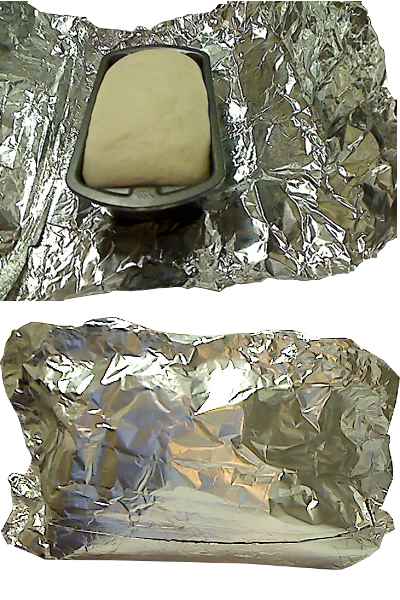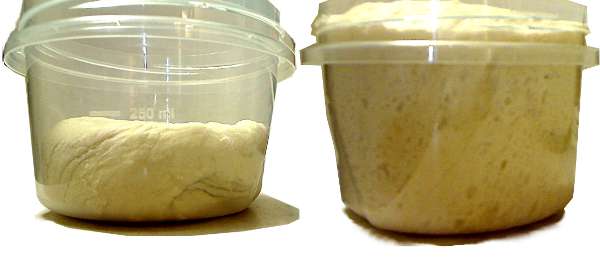
[ Equipment: steamer and slow cooker or oven. For more information about the terminology in this recipe, see Low Temperature Baking: A Journey of 3 Paths ].
Jan. 5, 2011 Note: A fast-rise, baked-only version of this recipe can be found here.
The name of this recipe has been changed to distinguish it from the many slow-rise recipes on VaporBaker. Also, at the time this recipe was written, I had not yet experimented with many low-temperature browning agents (for example, alkaline olive oil was first described in my REVISED slow-rise no-knead focaccia recipe, not the original recipe). The writeup below refers to the older version of focaccia.
---------------
Unlike my first focaccia bread which emerged from the oven very pale, this white loaf is adorned with a golden crust. The focaccia's lack of color might have been due to the falling oven, in which the temperature dropped from 250 to 225°F in the final 40 minutes. However, I did bake one at a steady 250°F throughout, and while that loaf singed at the edges (and dried out hard as a Frisbee), it never managed the even golden tonality of this mini loaf. The browning trick of this bread, the key difference in the recipes, is the addition of sugar to the dough, which begins caramelizing at 230°F and imparts color without searing heat.
This mini loaf is baked in 2 stages: steamed first and slow-baked at 250°F to finish. A regular loaf of bread baked at high temperature is done when the internal temperature reaches about 180°F. Water steam can heat well over 200°F (at sea level), so steaming is as effective as oven baking in an oven to cook the bread. For the finishing touch, the bread is then baked at 250°F to dry and brown the crust.

I have tested the bread dry steamed and wet steamed. Both techniques work, but dry steaming produces a drier surface that browns faster. To wet steam, the pan is put in the steamer and a piece of greased wax paper or foil is placed over the dough to protect it against any water dripping down from the lid. Despite the greasing, the paper or foil might stick to the bread anyway, leaving a rougher surface for the browning stage. To avoid that problem, don't cover the dough and cover the steamer instead with a dish towel under the lid to absorb moisture.


In dry steaming, steam doesn't touch the bread. The pan can be encased in a large foil pouch, seams along the top and sides. The pouch idea works best if the steamer is big, so it isn't a hassle to form a foil dome that will fit in the steamer with the cover on. An alternative is to make a foil bonnet that fits over the pan and is secured with string against the pan's rim. I make the bonnet by pressing a sheet of foil into a large loaf pan as the mold.
The bread should be steamed until it reaches an internal temperature of at least 180°F, by which time it's fully cooked. However, since the bread will be baked next, the steaming stage could end a little earlier, when the internal temperature is a degree or two less than 180°F, and the bread will finish cooking in the oven.
This mini or demi loaf is a great size for snack sandwiches, not too big and not too small. It tastes best if eaten soon after it's cooled, although it toasts up very well a day or two later. With the lessons from this recipe, I'm working out the details for a larger loaf and a new version of the focaccia.
Makes 1 Demi Loaf
- 540 calories per loaf
- Oven temperature: steaming, oven at 250°F/121°C
- 1-1/8 cup all-purpose flour
- 2 teaspoons sugar
- 1/2 teaspoon salt
- 1/4 teaspoon rapid rise yeast
- 1/2+ cup warm water

1. Put flour, salt, sugar and yeast into a large bowl and mix thoroughly.
2. Add 1/4 cup of warm water and mix. Continue adding warm water, one tablespoon at a time until it forms a sticky but kneadable dough.

3. Knead dough to form a smooth and elastic ball. If the dough is too dry, it won't rise properly. Sprinkle in water to hydrate it. If the dough's too wet to knead, mix in a little flour to absorb the excess water.
For this amount of dough, my favorite kneading method is to hold the dough in both hands and stretch-fold, as though I were making taffy candy, for 2 to 4 minutes, until the dough becomes elastic and will stretch about 1 foot without breaking. Do not overknead.

4. Cover and put in a warm place (90°-100°F) to rise until double in height, about 2 to 3 hours.

5. Deflate the dough. Briefly knead it. Shape and put dough in a small (5-3/4 inch x 3 inch) loaf pan.

6. Cover and put in warm place to rise until double in height, about 1 to 2 hours.
7. Prepare pan for dry or wet steaming as described in text above.
8. Preheat oven/cooker to 250°F.


9. Bring steamer water to rolling boil and reduce to a medium boil. Put bread in steamer and steam until the bread's internal temperature reaches 180°F or higher (about 40 to 50 minutes).

10. Remove bread from steamer. Remove pouch or any covering and put bread in oven or slow cooker and bake for about 40 minutes until crust is lightly golden. Do not overbake or the crust may harden. If baking in a slow cooker and the surface of the loaf is wet, position lid slightly askew for venting and bake for another 10 minutes to dry the crust.

11. Remove bread from oven/cooker and cool about 10 minutes. Unmold and continue to cool bread on a rack.

12. Slice and serve.


No comments:
Post a Comment